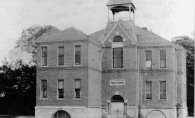Before World War I, many residents of the Lake Minnetonka area of German heritage were proud of their roots. In 1883, German nobility even visited the lake to celebrate James J. Hill’s completion of the Northern Pacific Railway by hosting a giant, elegant 10-course banquet for a thousand guests at the Hotel Lafayette “that made the triumph of a Roman emperor pale in magnificence,” according to publicity at the time. Special trains from New York arrived for the occasion, full of royalty from England, military officers, nine governors, nine generals, former President Ulysses S. Grant, sitting President Chester Arthur and environmentalist John Muir.
One of the German dignitaries, Herrn Mohr, wrote in his diary that “Lake Minnetonka and the Hotel Lafayette will from this day on be renowned … And the tables, ach Himmel! Never shall I see such long tables again during my life’s span!”
One of the most prominent men of the lake region was Sir Charles Gibson, who had helped the King of Prussia establish his government. In spite of his many honors, Gibson decided to live on the lake, which was considered remote at the time.
But World War I erased any good feelings with Germany. On June 15, 1917, President Woodrow Wilson passed a law demanding all men between 21 and 31 report for duty. Soon, a group of 160 “Hun Huskers” from around Lake Minnetonka left for the front.
Suddenly everyone was anti-German, even many people of German heritage. To fight the Germans on the home front and support the war effort, lake dwellers saved cooking fats and peach stones, which were used to make gas masks. Happenings Around Deephaven reported that each day of the week marked another local effort to defeat the Germans: “Wheatless Mondays and Wednesdays, meatless Tuesdays, and porkless Thursdays and Saturdays. On gasless Sundays, some people hitched horses to the front bumper of the family car, or stayed home and watched their war gardens grow.”
Of course, World War II didn’t do anything to ease tension with Germany, either. On Lake Minnetonka, the U.S. Defense Program performed an air raid drill on October 14, 1942 with a mandatory blackout all around the lake. All electricity had to be shut off and all cars pulled over. Apparently, Lake Minnetonka was considered a possible bombing target. According to Happenings Around Deephaven, “A dozen or more Cabin Cruisers belonging to our Coast Guard cruised the lake waters [to sweep] them clear of hidden mines.” The Coast Guard found nothing. “Lake Minnetonka was declared safe for rowboats,” continued the report—but suspicions still ran high.









